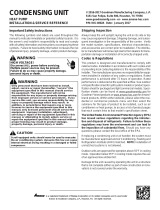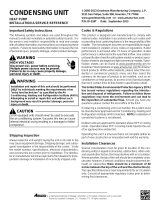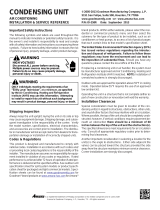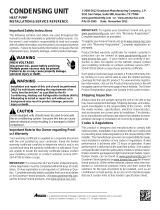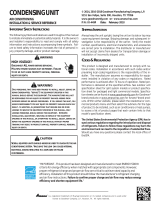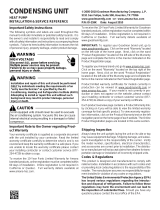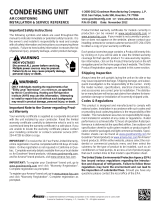
12
We strongly recommend a bi-annual maintenance checkup be performed
before the heating and cooling seasons begin by a qualied servicer.
Never operate unit without a lter in-
stalled as dust and lint will build up on internal parts resulting
in loss of eciency, equipment damage and possible re.
An indoor air lter must be used with your comfort system.
A properly maintained lter will keep the indoor coil of your
comfort system clean. A dirty coil could cause poor operation
and/or severe equipment damage.
Your air lter or lters could be located in your furnace, in a
blower unit, or in “lter grilles” in your ceiling or walls. The
installer of your air conditioner or heat pump can tell you
where your lter(s) are, and how to clean or replace them.
Check your lter(s) at least once a month. When they are
dirty, replace or clean as required. Disposable type lters
should be replaced. Reusable type lters may be cleaned.
You may want to ask your dealer about high eciency lters.
High eciency lters are available in both electronic and
non-electronic types. These lters can do a better job of
catching small airborne particles.
Compressor
The compressor motor is hermetically sealed and does not
require additional oiling.
Indoor and outdoor fan motors are permanently lubricated
and do not require additional oiling.
WARNING
Air must be able to ow through the outdoor unit of your
comfort system. Do not construct a fence near the unit or
build a deck or patio over the unit without rst discussing your
plans with your dealer or other qualied servicer. Restricted
airow could lead to poor operation and/or severe equipment
damage.
Likewise, it is important to keep the outdoor coil clean. Dirt,
leaves, or debris could also restrict the airow. If cleaning of
the outdoor coil becomes necessary, hire a qualied servicer.
Inexperienced people could easily puncture the tubing in the
coil. Even a small hole in the tubing could eventually cause
a large loss of refrigerant. Loss of refrigerant can cause poor
operation and/or severe equipment damage.
Do not use a condensing unit cover to “protect” the outdoor
unit during the winter, unless you rst discuss it with your
dealer. Any cover used must include “breathable” fabric to
avoid moisture buildup.
• Check the thermostat to conrm that it is properly set.
• Wait 15 minutes. Some devices in the outdoor unit or
in programmable thermostats will prevent compressor
operation for awhile, and then reset automatically. Also,
some power companies will install devices which shut
o air conditioners for several minutes on hot days. If
you wait several minutes, the unit may begin operation
on its own.
• Check the electrical panel for tripped circuit breakers
or failed fuses. Reset the circuit breakers or replace
fuses as necessary.
• Check the disconnect switch near the indoor furnace
or blower to conrm that it is closed.
• Check for obstructions on the outdoor unit . Conrm
that it has not been covered on the sides or the top.
Remove any obstruction that can be safely removed.
If the unit is covered with dirt or debris, call a qualied
servicer to clean it.
• Check for blockage of the indoor air inlets and outlets.
Conrm that they are open and have not been blocked
by objects (rugs, curtains or furniture).
• Check the lter. If it is dirty, clean or replace it.
• Listen for any unusual noise(s), other than normal op-
erating noise, that might be coming from the outdoor
unit. If you hear unusual noise(s) coming from the unit,
call a qualied servicer.
















